Mazda CX-5 Service & Repair Manual: Quick Release Connector Removal/Installation
WARNING:
-
Fuel is very flammable liquid. If fuel spills or leaks from the pressurized fuel system, it will cause serious injury or death and facility breakage. Fuel can also irritate skin and eyes. To prevent this, always complete the “Fuel Line Safety Procedure”, while referring to the “BEFORE SERVICE PRECAUTION”.
-
A person charged with static electricity could cause a fire or explosion, resulting in death or serious injury. Before draining fuel, make sure to discharge static electricity by touching the vehicle body.
CAUTION:
-
Disconnecting/connecting the quick release connector without cleaning it may cause damage to the fuel pipe and quick release connector. Always clean the quick release connector joint area before disconnecting/connecting using a cloth or soft brush, and make sure that it is free of foreign material.
Quick Release Connector Type
CAUTION:
-
Verify the type and location, and install/remove properly.
U.S.A. and CANADA
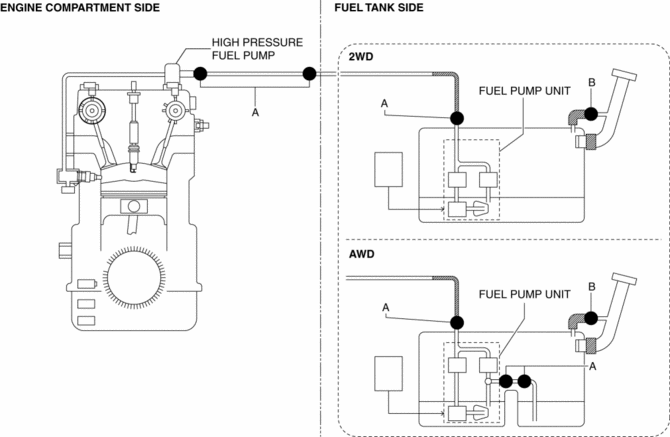
Except U.S.A. and CANADA
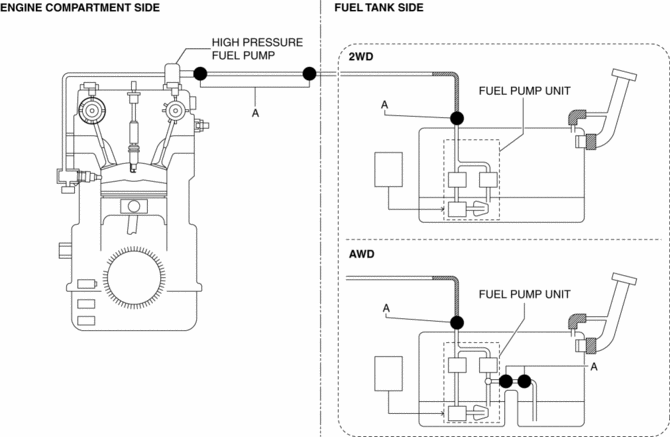
Type A Removal
1. Complete the “BEFORE SERVICE PRECAUTION”..
2. Move the retainer upward using a small flathead screwdriver or a similar tool.
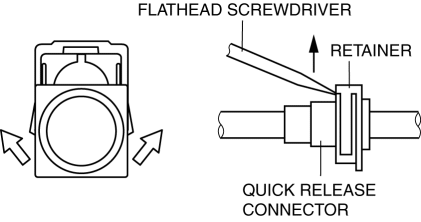
3. Pull out the fuel hose straight from the fuel pipe and disconnect it.
4. Cover the disconnected quick release connector and fuel pipe with vinyl sheeting or a similar material to prevent it from getting scratched or dirty.
Type B Removal
CAUTION:
-
Be careful not to damage the pipe when unlocking the retainer.
1. Complete the “BEFORE SERVICE PRECAUTION”..
2. Insert the SST into the quick release connector.
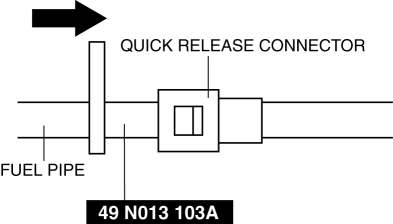
3. Pull the fuel hose straight out from the fuel pipe and disconnect it.
4. Cover the disconnected quick release connector and fuel pipe with vinyl sheeting or a similar material to prevent it from getting scratched or dirty.
Type A Installation
NOTE:
-
If the quick release connector O-ring is damaged or has slipped, replace the fuel hose.
-
A checker tab is integrated with the quick release connector for new fuel hoses. Remove the checker tab from the quick release connector after the connector is completely engaged with the fuel pipe.
1. Inspect the fuel hose and fuel pipe sealing surface for damage and deformation.
-
If there is any malfunction, replace it with a new one.
2. Apply a small amount of clean engine oil to the sealing surface of the fuel pipe.
3. Install the quick release connector.
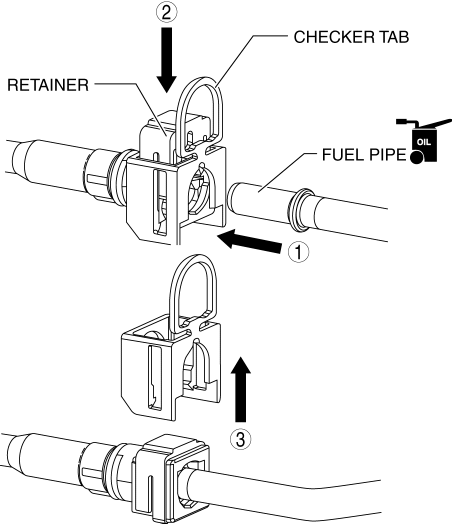
-
Insert the fuel pipe straight to the end of the quick release connector.
-
Push down the retainer using a finger.
-
If the retainer cannot be pushed down, push the fuel pipe further to the quick release connector.
4. Lightly pull and push the quick release connector a few times by hand, and then verify that it is connected securely.
5. Complete the “AFTER SERVICE PRECAUTION”..
Type B Installation
NOTE:
-
If the quick release connector O-ring is damaged or has slipped, replace the piping component.
-
A checker tab is integrated with the quick release connector for new fuel hoses and fuel hoses. Remove the checker tab from the quick release connector after the connector is completely engaged with the fuel pipe.

1. Inspect the fuel hose and fuel pipe sealing surface for damage and deformation.
-
If there is any malfunction, replace it with a new one.
2. Apply a small amount of clean engine oil to the sealing surface of the fuel pipe.
3. Install a new retainer to the quick release connector.
4. Reconnect the fuel hose straight to the fuel pipe until a click is heard.
5. Lightly pull and push the quick release connector a few times by hand, and then verify that it is connected securely.
6. Complete the “AFTER SERVICE PRECAUTION”..
 Quick Release (Fuel System) Connector
Quick Release (Fuel System) Connector
Purpose, Function
Serviceability has been improved by the easy disconnection/connection.
Construction
The following types of the quick release connectors are used.
U.S.A. and CAN ...
 Returnless Fuel System
Returnless Fuel System
Purpose, Outline
Fuel evaporation in the fuel tank is reduced by adjusting the fuel amount
(fuel pressure) ejected from the fuel pump and preventing fuel warmed in the
engine compartment ...
Other materials:
Wiper/Washer System Personalization
A customize function has been adopted which switches the auto wiper system
between operable/inoperable.
Using Mazda Modular Diagnostic System (M-MDS)
The auto wiper function can be enabled or disabled using the Mazda Modular
Diagnostic System (M-MDS). Refer to the Workshop M ...
Rear Washer Hose Removal/Installation
1. Disconnect the negative battery cable..
2. Remove the front over fender..
3. Remove the mudguard (RH)..
4. Disconnect the rear washer hose A from the washer motor.
5. Remove the rear washer hose A from the washer tank hook.
6. Remove the rear washer hose A from clips A and B.
7. Disco ...
Tachometer
Purpose
The tachometer notifies the driver of the engine speed.
Function
The instrument cluster controls the tachometer needle based on the engine
speed signal from the PCM and displays the engine speed per minute.
Construction
An analog needle display tachometer ...
